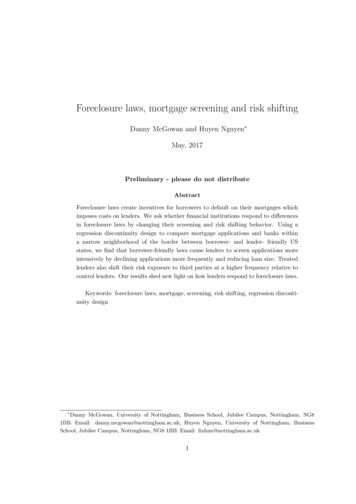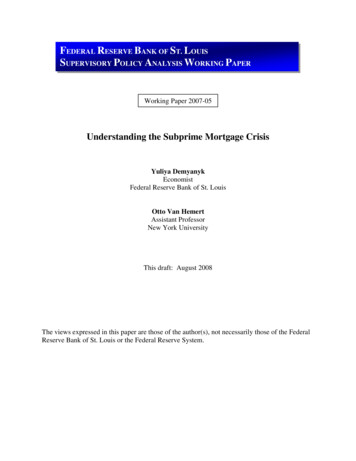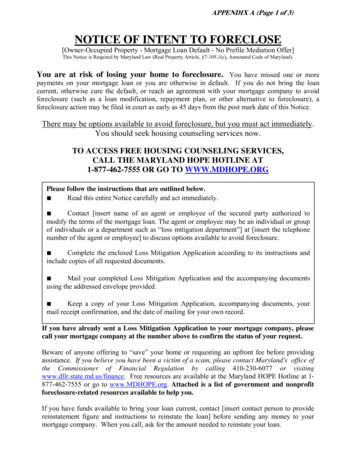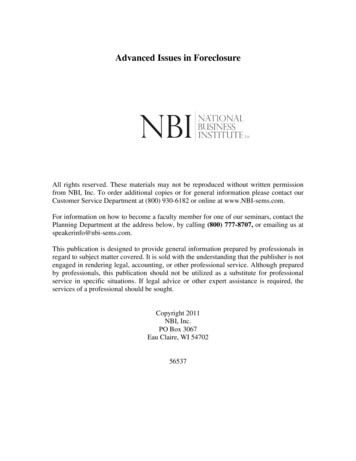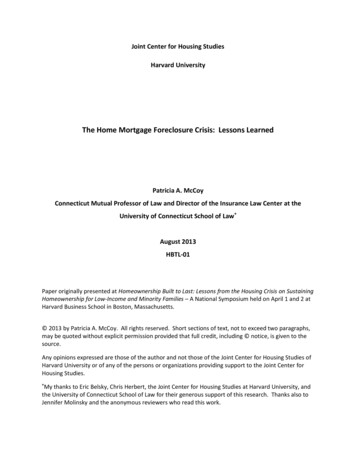
Transcription
Joint Center for Housing StudiesHarvard UniversityThe Home Mortgage Foreclosure Crisis: Lessons LearnedPatricia A. McCoyConnecticut Mutual Professor of Law and Director of the Insurance Law Center at theUniversity of Connecticut School of Law August 2013HBTL-01Paper originally presented at Homeownership Built to Last: Lessons from the Housing Crisis on SustainingHomeownership for Low-Income and Minority Families – A National Symposium held on April 1 and 2 atHarvard Business School in Boston, Massachusetts. 2013 by Patricia A. McCoy. All rights reserved. Short sections of text, not to exceed two paragraphs,may be quoted without explicit permission provided that full credit, including notice, is given to thesource.Any opinions expressed are those of the author and not those of the Joint Center for Housing Studies ofHarvard University or of any of the persons or organizations providing support to the Joint Center forHousing Studies. My thanks to Eric Belsky, Chris Herbert, the Joint Center for Housing Studies at Harvard University, andthe University of Connecticut School of Law for their generous support of this research. Thanks also toJennifer Molinsky and the anonymous reviewers who read this work.
From 2007 through 2011, the United States housing market suffered from a severeimbalance in supply and demand. 1 On the supply side, there were too many homes for sale andtoo many of those listings were for foreclosed homes. In addition, there were several millionhomes awaiting sale in the foreclosure pipeline.2 Many of these homes in the so-called“shadow housing inventory” eventually came on the market and pushed down house prices.The demand for homes was also depressed. In the aftermath of the financial crisis,banks tightened their lending standards. Meanwhile, millions of households suffered a declinein creditworthiness, making it difficult or impossible for them to get loans.Reducing the shadow housing inventory is one method to help correct the imbalance inhousing supply. There are two ways to reduce that inventory. One is through foreclosureprevention, to keep homes with distressed loans from entering the shadow inventory to beginwith. The other is to speed up sale of real estate owned (REO) on the back end.In this chapter, I will focus on foreclosure prevention. Foreclosure prevention addressesthe front end of the problem by keeping distressed borrowers in their homes. Where that isnot possible, foreclosure prevention partly addresses the back end of the problem by seeking a“graceful exit” for the borrower while expediting sale of the home to a new owner.We know that investors take heavy losses on foreclosures: on average, 50 percent ormore. This suggests that a significant portion of distressed mortgages could be and should beresolved short of foreclosure. In theory, servicers and investors should be willing to do a loanworkout whenever the net present value of loss mitigation exceeds the net present value offoreclosure. This “NPV” test defines the outer parameters of the loan workouts most servicerswill perform.3From society’s viewpoint, foreclosure prevention should have two major objectives.The first is designing loss mitigation plans to minimize the chance of redefault. The second is tokeep homes occupied whenever possible. Avoiding vacant homes is crucial to remedying theshadow inventory. Not only do these homes deteriorate in value, they attract crime and pushdown the value of neighboring homes.Consequently, foreclosure prevention should strive for a solution that keeps thehomeowner in the home. That means negotiating a loan modification whenever possible thatsatisfies the NPV test and is designed for success. But when that is not possible, the goal shouldbe a short sale to a buyer who will keep the home occupied. Doing so will help reduce thenegative externalities from abandoned homes.1See, e.g., Goodman et al., “Modification Effectiveness,” 2.CoreLogic estimated this inventory at 2.3 million houses as of October 2012. CoreLogic,“CoreLogic Reports Shadow Inventory Continues Decline in October 2012.”3Bernanke; Capozza and Thomson, 241-58; Cordell et al., “The Incentives of Mortgage Servicers,”3, 11-12.22
Most first-time loan modifications are behind us now 4 and we have substantialempirical evidence about what worked and what did not. In this chapter, I discuss the fourmain lessons from the last several years’ experience with loss mitigation, including structuralchallenges to reaching the right level of loan modifications.Loss Mitigation: Its Rationale And TechniquesThe high loss severity for foreclosures creates space for loss mitigation strategies thatresolve distressed mortgages at lower cost to both investors and borrowers. The mostcommon test for making that determination is the net present value or NPV test. Under theNPV test, a loan modification or other workout technique is deemed cost-effective when thenet present value of the workout exceeds that of going to foreclosure. Pooling and servicingagreements (PSAs) normally impose the NPV test on workouts of private-label loans and alsorequire servicers to maximize recovery for the benefit of the investors in the trust as a whole.Servicers are supposed to implement this requirement by choosing the higher NPV, as betweena loan workout and foreclosure. Federal loss mitigation programs impose their own NPV testsand many servicers also apply proprietary NPV tests to distressed loans held in portfolio.NPV tests have their limitations. For one thing, NPV tests can be manipulated becausePSAs give servicers of private-label loans wide discretion in how to calculate NPVs. Servicerscan choose whatever values they want for variables such as the expected sales price fromforeclosure, the discount rate applied to projected revenues from loan modification, and thechance of redefault. Investors have little ability to monitor or change the values that servicersuse for these inputs. 5 As a result, servicers can manipulate the NPV calculation for manydistressed private-label loans to achieve the outcomes they want. The same problem affectsthe NPV test for federal loan modifications and for loans held in portfolio, although to a lesserextent. 6In addition, it can be hard for distressed borrowers to meet the NPV test when theirincomes have plummeted. During the financial crisis, the collapse in home values caused morethan one-quarter of all borrowers to go underwater on their mortgages. Normally, negativeequity is a necessary condition for default but not sufficient. Most underwater borrowers who4See, e.g., Moody’s Investors Service, “US Private-Label RMBS and Servicer Quality,” 4.Cordell et al., “The Incentives of Mortgage Servicers,” 18; Thompson, “Why Servicers ForecloseWhen They Should Modify and Other Puzzles of Servicer Behavior,” 6-9, 18; Kiff and Klyuev, 8 n.10(discussing market forces affecting choice of discount rates). For Fannie Mae and Freddie Mac loans andloans evaluated for Home Affordable Modification Program (HAMP) modifications, this discretion ismore limited. The HAMP program, Fannie Mae, and Freddie Mac require servicers to use standardizedsoftware to calculate NPV. Cordell et al., “The Incentives of Mortgage Servicers,” 18; Credit Suisse.6Special Inspector General for the Troubled Asset Relief Program.53
default also suffer an income shock. 7 If that income shock is too severe—as is often the casewith unemployment—the borrower may not qualify for a loan modification under the NPV test.When loans go delinquent or are in danger of default, servicers have a variety ofworkout techniques at their disposal to resolve those loans short of foreclosure. (I use “loanworkout” broadly in this paper to refer to the full spectrum of techniques to resolve distressedloans short of refinancing or foreclosure). This large menu of options gives servicers discretionabout which technique to use.Like refinancing, some workout techniques allow the homeowner to retain ownership ofthe home. Of those, some lower monthly payments, while others do not. Capitalization takesthe borrower’s arrears and tacks them onto the principal, thereby increasing the monthlypayments, either immediately or later on. When capitalization includes forbearance, theservicer temporarily lowers the borrower’s monthly payments but adds the forborne sums tothe loan balance, meaning that the loan payments will eventually go even higher. Whencapitalization does not involve forbearance, the monthly payments immediately go up. Oneway or the other, capitalization alone does not involve modification of any loan terms.Loan modifications, in contrast, alter the loan terms, either by extending the term of theloan, reducing the interest rate, lowering the principal, or some combination of the three. Manyloan modifications have the effect of lowering monthly payments.Capitalization and modifications share the ostensible objective of keeping homeownersin their homes. Other workout techniques result in liquidation and normally requirehomeowners to vacate their homes. In a short sale, for example, the servicer allows a borrowerto sell the home for less than the outstanding loan balance and often forgives the remainingamount due. In a deed-in-lieu-of-foreclosure, the borrower deeds the house to the servicer andmoves out, in exchange for full forgiveness of the debt. In some cases, however, the servicermay lease the home back to the borrower, relieving any need to vacate the home.The Federal Government’s Evolving Approach To Loss Mitigation During The CrisisIn 2007 and 2008, the first two years of the financial crisis, private loss mitigation effortsby servicers were haphazard, with low success rates. In mid-2007, at the urging of the GeorgeW. Bush Administration, the mortgage industry launched the HOPE NOW Alliance to promotegreater foreclosure prevention. The objective of HOPE NOW was to get distressed borrowers7See Foote et al., “A Proposal to Help Distressed Homeowners.” The exception is for deeplyunderwater homeowners, who may decide their home are worthless investments and walk away fromtheir mortgages. Ibid.4
into loan counseling and to convince servicers to grant them proprietary loan modificationswhenever possible.HOPE NOW was strictly voluntary and did not offer financial incentives for lossmitigation. Similarly, HOPE NOW did not recommend a standardized template for loanmodifications or a numerical target for lower loan payments. As a consequence, servicersvaried widely in their approach to and handling of loan workout requests. According to HOPENOW reports, between July 2007 and October 2012, the program completed over 15 millionloan workouts. Only 32 percent of those workouts (4.81 million) were proprietary loanmodifications, however. The remaining 68 percent (10.34 million) resulted in liquidation ordeferred or rescheduled borrowers’ payments temporarily without permanently lowering thosepayments. Furthermore, the proportion of proprietary loan modifications to other types ofworkouts fell in recent years, from about 50 percent in December 2008 to 31 percent inOctober 2012. 8HOPE NOW’s initial performance was disappointing. During 2007 and 2008, only 8.5percent of mortgages that were at least 60 days past due received loss mitigation of any kind(whether a loan modification, a short sale, or a deed-in-lieu-of-foreclosure). 9 Furthermore, themajority of loan modifications in 2007 and 2008 actually raised borrowers’ monthly paymentsinstead of lowering them. 10 For homeowners who were already struggling to meet theirpayments, these loan modifications were often destined for failure.Sheila Bair, the Chairman of the Federal Deposit Insurance Corporation (FDIC), used theoccasion of the failure of the mortgage lender IndyMac to spearhead a better approach to loanmodifications. When IndyMac failed in 2008, the FDIC took over as IndyMac’s conservator andassumed the servicing of more than 60,000 seriously delinquent mortgage loans.11 The agencytook that opportunity to implement a uniform template for loan modifications that wasdesigned to handle the growing volume of distressed loans at IndyMac.Under the program, known as “Mod in a Box,” the FDIC evaluated IndyMachomeowners who were at least 60 days past due on their mortgages for loan modifications.The FDIC’s goal was to lower monthly payments, not raise them, by reducing the borrower’sfront-end debt-to-income (DTI) ratio to 38 percent, subject to maximizing NPV. To get the DTIdown to 38 percent, Mod in a Box instituted a standardized “waterfall” of workout techniques.The first step was to capitalize arrears. If more was needed to reduce the DTI ratio to 38percent, then the FDIC lowered the interest rate. After that, the term could be extended, and ifmore was needed to hit the 38 percent target, the FDIC could grant the borrower principalforbearance.1289101112HOPE NOW, 4, 7.Adelino, Gerardi, and Willen, 13-18 and table 5.Adelino, Gerardi, and Willen, 11-12 and table 3.Brown.Brown.5
To induce servicers to cooperate, the FDIC paid them 1,000 for every IndyMac loanthey modified through Mod in a Box. By February 1, 2009, 9,901 or about 26 percent ofIndyMac’s seriously delinquent loans had been modified. 13 Over time, the FDIC succeeded inlowering the redefault rates on later IndyMac loan modifications compared with thoseperformed before April 2009. 14In late 2008, the new Federal Housing Finance Agency (FHFA) unveiled a parallelstreamlined loan modification program for delinquent loans guaranteed by Fannie Mae andFreddie Mac. 15 Previously, starting in the 1980s, the two government-sponsored entities (GSEs)had instituted their own proprietary loss mitigation programs for distressed mortgages.16Neither program had used a standardized waterfall designed to lower mortgage payments.17Both of these proprietary GSE programs reported disappointing results. In 2008, forinstance, troubled GSE mortgages were less likely to be modified than loans held in portfolio oreven private-label mortgages. That same year, workouts of GSE loans had smaller interest ratereductions on average than workouts of portfolio loans, which in turn had smaller interest ratecuts on average than private-label loan modifications. 18 Lack of affordability was also aproblem. In 2008, over half of GSE loan modifications increased monthly loan payments. 19Accordingly, it came as no surprise that the redefault rates for GSE loan modifications made in2008 and 2009 were substantially worse than in later years, after both GSEs overhauled theirproprietary loan modification protocols to lower monthly payments. 20Frustrated with these and other ad hoc approaches to foreclosure prevention that didnot result in lower payments for distressed borrowers, the Obama Administration announcedits own loss mitigation program, called “Making Home Affordable” (MHA), in February 2009.13Kiff and Klyuev, 16-18.Brown, 5, 11.15Cordell et al., “Designing Loan Modifications to Address the Mortgage Crisis and the MakingHome Affordable Program,” 19; Federal Housing Finance Agency, “Foreclosure Prevention & RefinanceReport: Third Quarter 2009,” 18; Kiff and Klyuev, 16-18.16For descriptions of GSE and FHA loss mitigation programs and technologies before 2009, see AbtAssociates; Crews Cutts and Green, “Innovative Servicing Technology,” 5-7, 13-15; Crews Cutts andMerrill, “Interventions in Mortgage Default.”17See Federal Housing Finance Agency, “Foreclosure Prevention Report: Second Quarter 2009,” 8(comparing the GSEs’ prior proprietary loan modification programs with HAMP). For example, CrewsCutts and Green described GSE repayment plans at the time, which typically resulted in higher ratherthan lower monthly payments because the plans required people to resume their regular monthlypayments plus pay off the arrears. See Crews Cutts and Green, “Innovative Servicing Technology,” 6, 21.18See, e.g., Agarwal et al., “Market-Based Loss Mitigation Practices for Troubled MortgagesFollowing the Financial Crisis,” 3, 16, 19. However, the GSEs were more likely on average to refinancetroubled mortgages. Ibid.19See Federal Housing Finance Agency, “Report to Congress: 2010,” 4.20Compare Federal Housing Finance Agency, “Report to Congress: 2010,” 4-8, with FederalHousing Finance Agency, “Foreclosure Prevention Report: Second Quarter 2009,” 12.146
MHA was funded with 36.9 billion in Troubled Asset Relief Program (TARP) funds. Mod in aBox and FHFA’s own streamlined program formed the model for the Obama Administration’sapproach to loan modifications.MHA’s main feature was a loan modification program called the Home AffordableModification Program or HAMP. HAMP revamped the protocol for loan modifications in threeimportant ways. First, HAMP sought to alter the NPV calculus and the compensation incentivesof servicers by paying subsidies for modifications of owner-occupied loans that were NPVpositive. Second, HAMP instituted a standardized loan modification waterfall for participatingservicers to make modifications more successful and to bring those modifications to scale.Finally, as part of that waterfall, HAMP required servicers to lower borrowers’ monthlypayments to 31 percent of gross monthly income for five years, first by lowering interest ratesas far down as 2 percent, then by extending the loan term to up to 40 years, and then, ifnecessary, by forbearing (or, at the servicer’s option, forgiving) part of the principal.When HAMP was unveiled, the Administration predicted that it would assist 3 to 4million homeowners restructure their mortgages by its original end date of December 31,2012.21 HAMP fell short of that goal, completing only 1.136 million permanent loanmodifications as of December 2012. 22 Meanwhile, newly initiated foreclosures consistentlyoutstripped permanent modifications (taking proprietary and HAMP modifications together)from third quarter 2011 through third quarter 2012, sometimes by as much as two to one. Thetrend for earlier quarters was similar. 2321Department of the Treasury, “Homeowner Affordability and Stability Plan Executive Summary.”The Treasury Department later extended the HAMP program through December 31, 2013.22Making Home Affordable, “Program Performance Report Through December 2012,” 3.23Office of the Comptroller of the Currency, “OCC Mortgage Metrics Report: Fourth Quarter2011,” 22, 24; Office of the Comptroller of the Currency, “OCC Mortgage Metrics Report: Third Quarter2012,” 5, 24.7
Total Foreclosure Starts to Total Modifications,3Q 2011 - 3Q 2012400000350000300000250000200000Total Modifications150000Foreclosure Starts1000005000003Q 2011 4Q 2011 1Q 2012 2Q 2012 3Q 2012Source:OCC MortgageMetricsDespite this track record, HAMP had certain successes. The program’s emphasis onlower monthly payments and lower interest rates cut redefault rates substantially.Furthermore, HAMP improved over time in response to feedback. Some of the later changes toHAMP—especially the decision to triple the subsidies for principal reductions—further raisedthe success rate of HAMP modifications.A Taxonomy Of Distressed MortgagesIn thinking about distressed mortgages and the best way to resolve them, it isworthwhile to evaluate loans along three different dimensions. The first consists of the home’soccupancy prospects. This dimension evaluates whether the house is occupied and, if so,whether there is a cost-effective loss mitigation technique that will keep the house occupied,either by the borrower or someone else. The second dimension is the ownership status of theloan, i.e., whether the loan is held in portfolio or sold and, if so, to whom. The last dimensionconsists of the presence or absence of junior liens.Occupancy ProspectsLet’s turn first to occupancy prospects. This dimension can be broken down into threebasic categories: currently occupied homes involving delinquent borrowers with sufficient cashflow to pass an NPV test; currently occupied homes that involve delinquent borrowers withoutsufficient cash flow; and vacant homes.Most servicers, before they agree to modify a loan, will first determine whether amodification will increase the net present value of the loan relative to foreclosure. When anowner-occupant borrower has enough cash flow to make a loan modification NPV-positive,8
normally a loan modification can and should be designed to keep the homeowner in thehome.24Owner-occupant borrowers who lack sufficient income to qualify for a traditional loanmodification under an NPV test present a different and more complicated situation. There arevarious reasons why a borrower might experience such a large cash shortfall. Some borrowerssuffer an income shock that is long-term or permanent in nature, such as shocks due todisability, retirement, a spouse’s death, or divorce. Other borrowers lose their jobs, resulting ina steep income loss that may nevertheless be temporary in nature.25 A third situation involvesborrowers who could meet their loan payments when they lived in their homes, but had tomove—often for new job postings—and could not sell their old homes for enough to pay offtheir mortgages due to negative equity. Some borrowers in this situation cannot afford dualhousing payments and end up defaulting. In the most extreme version of this scenario, theborrowers are members of the U.S. armed forces who have received orders to move.Finally, some distressed borrowers move out of their homes. Sometimes the departingborrowers rent their houses out; more often, their houses become vacant when they leave.Some vacant houses are awaiting foreclosure and will eventually go to sheriff’s sale. Othervacant houses have gone through foreclosure and sale and are now sitting in inventory as bankreal estate owned (REO). In the most difficult cases, sometimes referred to as “zombie loans,”servicers refuse to even initiate foreclosure, sometimes because the owner of the loan does notwant to assume title or the legal obligations that go with it, putting the house in legal limbo. 26In other cases, second lienholders create hold-up problems that discourage the first lienholderfrom proceeding to foreclosure.27 These situations are especially difficult to resolve because noone takes responsibility for the upkeep of the home.Ownership Status Of The LoanThe ownership status of a distressed loan can also affect the servicer’s flexibility to grantloss mitigation and the type of mitigation that can be offered.28 Distressed mortgages held inportfolio are the easiest to resolve short of foreclosure because the servicer has the fullpanoply of loss mitigation tools at its disposal.The remaining mortgage loans are owned by investors. In the main, these investors aredivided into two groups: investors in mortgage-backed securities issued by Ginnie Mae or theGSEs (Fannie Mae and Freddie Mac) and investors in private-label securities. Both the GSEs and24Many of these same reasons apply to distressed loans held by landlords of residential rentalproperties that are currently occupied by tenants.25At a minimum, usually such an income decline is 25 percent or more. See Foote et al., “AProposal to Help Distressed Homeowners,”2 n.4.26See, e.g., Government Accountability Office, “Vacant Properties.”27Agarwal et al., “Second Liens and the Holdup Problem in First Mortgage Renegotiation,” 16-17,19 (liquidation is less likely when a servicer of a securitized first-lien loan holds the second-lien loan inportfolio).28See, e.g., Gelpern and Levitin.9
private-label securitizations place limitations on the types of loss mitigation techniques thatmay be used. As of this writing, for example, the GSEs do not permit principal forgiveness inloan modifications.Similarly, in private-label securitizations, the pooling and servicing agreement (PSA) forthe loan pool usually places constraints on the servicer’s ability to negotiate a workout.Nevertheless, the majority of PSAs permit some degree of loan modifications in the event ofdefault, imminent default, or reasonably foreseeable default.29Most PSAs give servicers broad discretion to negotiate forbearance that temporarilyextends delinquent payments but does not require a change of loan terms, so long as theservicer forwards the missed payments to investors in a timely fashion. 30 While PSAs areusually stricter about permanent loan modifications, they vary widely from deal to deal. 31 Asmall percentage of PSAs—roughly 10 percent—prohibit any material loan modifications. 32 Theremaining PSAs do permit material loan modifications, but only when they are in the bestinterest of investors. 33 In such cases, the servicer’s precise latitude to negotiate a loanmodification will depend on the PSA. Many PSAs permit modification of all loans. Anothergroup, consisting of about 35 percent of PSAs, limits modifications to 5 percent of the loan pool(measured by the loan amount or number of loans). PSAs may contain other restrictions onloan modifications. Examples include mandatory trial modification periods, use of specificresolution procedures, caps on interest rate reductions, restrictions on the types of eligibleloans, and limits on the number of modifications in any one year.34For the 90 percent or so of private-label securitizations that allow loan modifications tosome degree, it is not clear whether PSA limits on those modifications ever became binding. ABerkeley survey of PSAs concluded that “large-scale modification programs [could] beundertaken without violating the plain terms of PSAs in most cases.” 35 Even for securitizationsthat prohibit loan modifications outright or cap them at 5 percent, some of those PSAs wereamended to allow more modifications.36 In addition, credit rating agencies no longer countmodified loans that are current 12 months after modification against the 5 percent cap where29Credit Suisse, 6; Hunt, 7. Among other things, this has the salutary benefit of allowing servicersto contact borrowers before any payments are missed to determine the borrower’s ability to handle thenew payments and, if not, to explore other options.30Credit Suisse, 6; Hunt, 7.31See generally Eggert, 279-97.32Credit Suisse; Hunt, 6.33Hunt, 7-9. In general, any change in the principal balance, the interest rate, or the final maturitywill constitute a “material” modification. Hunt, 7.34Credit Suisse, 67; Kiff and Klyuev, 11.35Hunt, 10. See also Adelino, Gerardi and Willen, 13-18 and table 5; Thompson, “ForeclosingModifications,” 755.36Most PSAs allow caps on loan modifications to be waived upon consent by a rating agency or abond insurer; only a few require investor approval. Kiff and Klyuev, 11.10
one exists. 37 Thus, while servicers faced challenges in complying with multiple PSAs containinga hodgepodge of provisions, for the most part those agreements did not constrain their abilityto modify distressed loans.Lien StatusThe lien status of a distressed mortgage can also affect the prospects for loss mitigation,because the presence of a junior lien can complicate a loan workout. About 25 percent ofmortgages originated between 2004 and 2009 had one or more junior liens. 38 Junior liens wereeven more prevalent in borrowers with first mortgages held in private-label securitized trusts.By year-end 2009, over half of private-label mortgages had second liens, compared to 18percent of GSE loans. 39Borrowers with negative equity are also more likely to have junior liens. That comes asno surprise because junior liens boost combined loan-to-value ratios. As of second quarter2012, 4.2 million underwater borrowers had second liens, with an average combined loan-tovalue ratio of 128 percent. 40It is also instructive to look at who owns junior liens. In the first quarter of 2011, only 2percent of the outstanding 929 billion in closed-end junior mortgages and home equity lines ofcredit (HELOCs) were held by securitized trusts; the vast majority of the rest was held bydepository institutions and credit unions. Together that quarter, four of the nation’s largestbanks—Bank of America, Wells Fargo, JP Morgan Chase, and Citigroup—held 43 percent of alloutstanding closed-end mortgages and HELOCs in portfolio.41This imbalance between bank ownership of junior liens and investor ownership ofprivate-label securitized first-lien loans creates principal-agent conflicts for banks that serviceprivate-label first liens and their own junior liens. From the viewpoint of investors, servicersshould write down their seconds before modifying distressed private-label firsts. However,servicers may be reluctant to do so, because write-downs will reduce earnings, as well as bankcapital. 42 The capital implications alone are staggering, given that total outstanding secondmortgages on banks’ books equaled over half of all bank capital in 2011.43Evidence suggests that junior liens impede loan modifications. In general, it is difficultto study the effect of the presence of junior liens on a distressed homeowner’s prospects for37Thompson, “Foreclosing Modifications,” 755.Been, Jackson, and Willis, “Sticky Seconds,” 4.39Goodman et al., “Second Liens: How Important?,” 19-30; Prior, “Less than One-in-Five GSE Loanshold a Second Lien.”40CoreLogic, “CoreLogic Reports Number of Residential Properties in Negative Equity DecreasesAgain in Second Quarter of 2012,” 2.41Goodman et al., “The Case for Principal Reductions,” 38-40; see also Been, Jackson, and Willis,“Sticky Seconds,” 4; Goodman et al., “Second Liens: How Important?,” 25-27.42See, e.g., Agarwal et al., “Market-Based Loss Mitigation Practices,” 16 (distressed second-lienpiggyback loans are less likely to be modified than first-lien loans).43Lee, Mayer, and Tracy.3811
loan modification because most datasets do not allow researchers to identify which secondliens are linked to particular first-lien loans. Two innovative studies overcame that hurdle,however, and found that first-lien mortgages with junior liens were less likely to be modifiedthan first-liens with none. 44 A third study45 reported tha
deed-in-lieu-of-foreclosure, the borrower deeds the house to the servicer and moves out, in exchange for full forgiveness of the debt. In some cases, however, the servicer may lease the home back to the borrower, relieving any need to vacate the home. The Federal Government's Evolving Approach To Loss Mitigation During The Crisis



